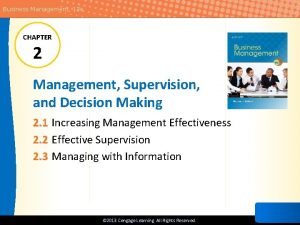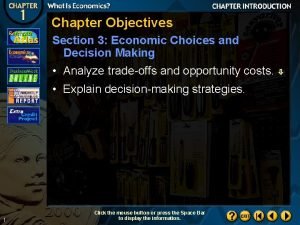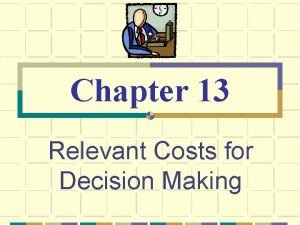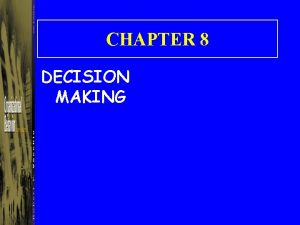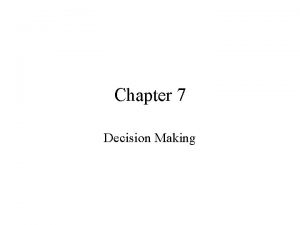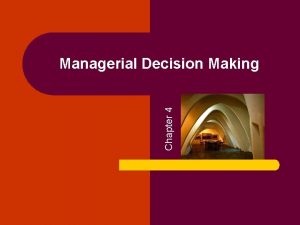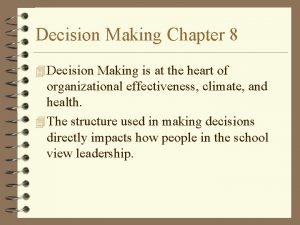Prices and Decision Making Chapter 6 Prices As

















- Slides: 17

Prices and Decision Making Chapter 6

Prices As Signals Price – monetary value of a product est. by supply and demand – “Signal” Prices help producers and consumers decide the 3 basic questions: 1. 2. 3. WHAT to produce HOW to produce it FOR WHOM to produce

What would life be like without prices? • Intelligence? good looks? political connections? • Communist countries often answer the 3 basic questions in economics. • Rationing • Usually unfairly distributed • Cost of distributing, enforcing, issuing coupons • Negative impact on the incentive to produce

Prices as a system • Non price allocation systems are typically corrupt • The price systems help individuals make decision and serve as a signal for suppliers • Ex. Ebay; Craigslist

Ch. 6 Sec. 2 Price System at Work Price of pizza Quantity of pizza demanded (per week) Quantity of pizza supplied (per week) $25 100 800 $20 210 700 $15 300 625 $10 500 $5 650 300

Market Equilibrium Price

Changes In Equilibrium Example 1: Suppose that the price of Chinese food delivery rises. What happens to the market for pizza? Let's figure this out with a 3 step approach: Step 1: Will this affect the demand or supply curve? • Chinese food is a substitute for pizza, so the price of chinese food affects the demand curve Step 2: In what direction will the affected curve move? • The price of chinese food, a substitute, INCREASES, so the demand for pizza INCREASES, or the demand curve shifts right. Step 3: What is the resulting impact on the equilibrium price and quantity? • This is easiest to answer with a graph. If you look at the graph below you will see that the new equilibrium has a higher price and larger quantity. An increase in demand results in an increase in price and quantity.

Example 2: Suppose instead that the Chinese food business is incredibly popular and profitable. What happens to the market for pizza? Again, we use the same three step approach: Step 1: Will this affect the demand or supply curve? • The chinese food business is an alternative to the pizza business, affecting the supply curve Step 2: In what direction will the affected curve move? • The profitability of chinese food means that some pizza places will switch to chinese food places, so the supply of pizza DECREASES, or the supply curve shifts left. Step 3: What is the resulting impact on the equilibrium price and quantity? • This is easiest to answer with a graph. If you look at the graph below you will see that the new equilibrium has a higher price and smaller quantity. An decrease in supply results in an increase in price and a decrease in quantity.

Market Equilibrium Changes In Equilibrium Bad News for Orange Juice Fanatics Orange Juice Prices Could Skyrocket After Freeze Destroys Most of California Output City News

Price Ceilings & Floors • A price ceiling is a legal maximum that can be charged for a good. • Results in a shortage of a product • Common examples include apartment rentals and credit cards interest rates. Price Ceilings are always below Equilibrium Price

Price Floors and Ceilings

A shortage occurs when quantity demanded exceeds quantity supplied. A shortage implies the market price is too low. Example: Many cities have rent control laws to make sure that poor people can find apartments they can afford. But landlords do not find it profitable to rent at these prices and sometimes convert their buildings to condominium or cooperative ownership. This reduces the number of apartments available: it creates a shortage.

A surplus occurs when quantity supplied exceeds quantity demanded. • A surplus implies the market price is too high. Example: The prices of many agricultural commodities, such as milk for instance, are subject to government price support. This higher price encourages farmers to produce too much: this creates surpluses. For instance, in the 1980's, the government has been forced to make cheese from milk surplus and to distribute that cheese free to poor people.

Price Ceiling A price ceiling is set at $2 resulting in a shortage of 20 units.

Rent Control - NYC

Price Floor A price floor is a legal minimum that can be charged for a good. • Results in a surplus of a product • Common examples include soybeans, milk, minimum wage A price floor is set at $4 resulting in a surplus of 20 units.

 Chapter 6 prices and decision making assessment answers
Chapter 6 prices and decision making assessment answers Objectives of decision making
Objectives of decision making Investment decision financing decision dividend decision
Investment decision financing decision dividend decision Chapter 11 decision making and relevant information
Chapter 11 decision making and relevant information Chapter 2 economic systems and decision making answer key
Chapter 2 economic systems and decision making answer key Management chapter 5 planning and decision making
Management chapter 5 planning and decision making Chapter 2 economic systems and decision making
Chapter 2 economic systems and decision making Chapter 2 economic systems and decision making answer key
Chapter 2 economic systems and decision making answer key Chapter 11 decision making and relevant information
Chapter 11 decision making and relevant information Chapter 2 management supervision and decision making
Chapter 2 management supervision and decision making Relevant information for decision making
Relevant information for decision making Options-based planning
Options-based planning Chapter 1 section 3 economic choices and decision making
Chapter 1 section 3 economic choices and decision making Financial decision making process
Financial decision making process Copyright
Copyright Relevant cost for decision making solution chapter 13
Relevant cost for decision making solution chapter 13 Decision tree and decision table examples
Decision tree and decision table examples Using recursion in models and decision making
Using recursion in models and decision making









